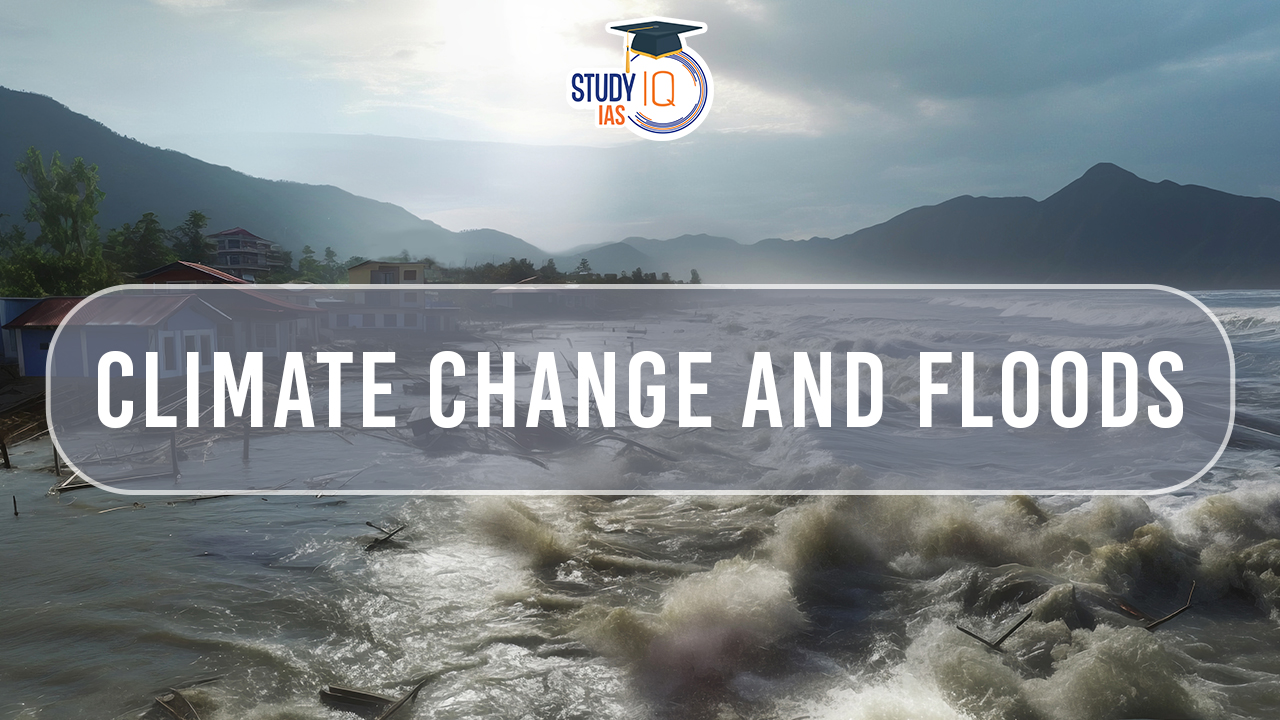Table of Contents
Context: Recent floods in countries like Libya, Greece, Turkey, and China have led researchers to link them with climate change due to the rising frequency and severity of these events.
How Can Climate Change Cause Floods?
- More intense precipitation: A warmer atmosphere can hold more water vapor, which means it can produce more intense precipitation events. This can lead to flash floods and river floods.
- For example, the 2018 floods in Kerala, which saw 414 mm of rain in just three days.
- For every 1-degree Celsius rise in average temperature, the atmosphere can hold about 7% more moisture.
- Sea level rise: As the planet warms, glaciers and ice sheets melt, and the oceans expand. This causes sea levels to rise, which makes coastal areas more vulnerable to flooding.
- According to a 2022 report by NOAA Climate, the global mean sea level has risen about 21–24 centimeters since 1880.
- Higher frequency and intensity of tropical cyclones: Warmer sea surface temperatures provide more energy for tropical cyclones to form and intensify.
- A study published in the journal Nature Climate Change in 2020 found that the number of intense tropical cyclones (Category 4 and 5) in the Bay of Bengal has increased by 50% since the 1970s.
- Glacial Lake Outbursts: Melting glaciers from rising temperatures can form glacial lakes in mountains. If these lakes grow too large or unstable, they may breach natural dams or ice barriers, causing catastrophic glacial lake outburst floods (GLOFs).
- The rapid melting of Himalayan glaciers is increasing the risk of flooding in downstream areas, such as the Ganges River basin.
- Slow-Moving Storms: Increasing temperatures at the poles result in slower movement of storms in the mid-latitudes. As a result, storms linger longer at a specific place resulting in intense rainfall in one location within a short period of time.
Urban Flood Risk due to Climate Change
Urban areas are more prone to climate change-related flood risk for several reasons:
- Impervious surfaces: Impervious surfaces, such as roads, and buildings which prevent water from infiltrating the ground, which increases the amount of runoff during heavy rainfall events.
- Land Use Changes: Urban development often involves altering natural landscapes, such as wetlands and forests, into impermeable surfaces which reduces the land’s ability to absorb water.
- Encroachment of wetlands is among the major reasons for the Chennai floods in 2015.
- Urban Heat Island Effect: Cities tend to have higher temperatures than surrounding rural areas due to the heat-absorbing properties of buildings and pavement. This can intensify evaporation and atmospheric moisture, potentially leading to more localized heavy rainfall and flash floods.
- Socioeconomic Factors: Urban areas often have concentrated populations and infrastructure, making them more susceptible to the socioeconomic impacts of floods.
- Limited Green Spaces: Many urban areas have limited green spaces and natural buffers, which can help absorb excess water during heavy rainfall.
Way Forward
- Climate change mitigation: Measures such as reducing GHG emissions, transition to renewable energy sources, reforestation and afforestation, wetland restoration, promoting sustainable land use planning, and enhancing agricultural practices etc.
- Climate change adaptation: Measures such as floodplain zoning, early warning system, investing in flood-resilient infrastructure, integrated watershed management, improving building codes, and enhancing community preparedness etc.
- Measures to mitigate urban flood risk:
- Climate-Resilient Infrastructure: This includes incorporating green infrastructure, such as bioswales, permeable pavements, and rooftop gardens, which can absorb and store rainwater.
- Developing Sponge Cities: The idea of a sponge city is to make cities more permeable to enhance the capacity of cities to absorb, store, and utilize rainwater.
- Urban Drainage Systems: Implement proper watershed management and develop emergency drainage plans. Regular maintenance of drains and stormwater channels is essential.
- Role of Technology: Use of predictive precipitation modeling, geospatial frameworks for vulnerability assessments, and innovative tools for flood management.
- Urban planning with nature-based solutions: (see the image)



 UPPSC Previous Year Question Papers, Dow...
UPPSC Previous Year Question Papers, Dow...
 Most Commonly Used Cancer Drugs and Thei...
Most Commonly Used Cancer Drugs and Thei...
 Tansen Biography, Musical Legacy and Mas...
Tansen Biography, Musical Legacy and Mas...





















